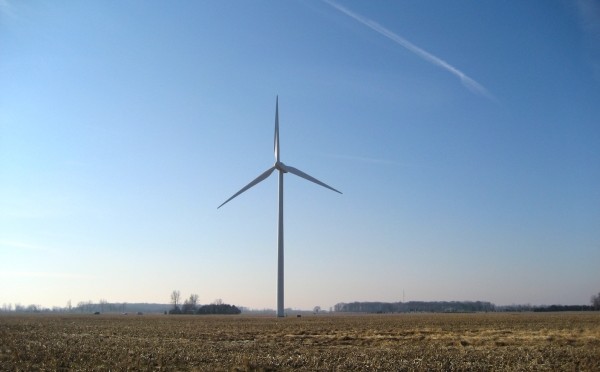Gov. John Kasich has an opportunity to retain a wind industry in Ohio if he uses his line-item veto on Monday to remove an anti-wind-energy provision from the budget bill – with $2.5 billion in current investment, hundreds of millions in local leases and tax payments, over 60 factories, and thousands of Ohio jobs on the line.
On Friday, Ohio became the first state to slow down its clean energy progress, despite the billions of dollars and thousands of jobs generated by the sector. The passage of Ohio’s Senate Bill 310 freezes the state’s renewable electricity standard for two years, and will have a chilling effect on renewable energy development. It may encourage developers and manufacturers to move to neighboring states with similar resources and friendlier business climates.
“The U.S. wind industry is disappointed in Friday’s news, but hopeful that Gov. Kasich will demonstrate his commitment to an ‘all-of-the-above’ energy strategy by encouraging legislative leaders to restart and strengthen the state’s commitment to renewable energy through the S.B. 310 study process,” said Rob Gramlich, Senior Vice President of Public Policy of the American Wind Energy Association. “Meanwhile, the Governor has stated his interest in having renewable energy as part of the state’s energy mix. If wind is to be part of that mix, he must use his line-item veto power on Monday to remove the punitive setback requirement in the budget bill.”
Besides the slowdown the industry may experience as a result of Senate Bill 310, increasing Ohio’s setback limits in the budget bill would effectively kill the $2.5 billion worth of projects now in development, and billions more in the planning stages. The state already requires turbines to be located at least 1,300 feet from the nearest inhabited residence, among the most restrictive policies in America. A provision added to the budget bill, H.B. 483, would dramatically increase that requirement to apply to a turbine’s distance from the nearest property line, not just the nearest home. Wind energy companies say that would make it impossible to cost-effectively site any further wind farms in Ohio:
“It appears designed to make the construction of utility-scale wind farms commercially unviable,” wrote Gabriel Alonso, CEO of EDP Renewables North America, in a June 4 letter to Gov. Kasich. He said his company’s Timber Road project represents a $200 million investment in Paulding County and has “tremendous local support,” and that EDP plans another $800 million of investment in Ohio, “all of which would be devastated by this provision.”
Bryan Schueler, Senior Vice President of Development at Invenergy, North America’s largest independent wind power generation company, said the company is “concerned about the future of wind energy development in the Buckeye State.” The $800 million that Invenergy is ready to invest in Ohio “is in jeopardy,” he said, including projects in Hardin County and Darke County that would bring construction and operation jobs, and millions of dollars in annual local tax revenue.
Mark Goodwin, President of Apex Clean Energy, wrote Gov. Kasich last Thursday, June 12, that his company has more wind energy development projects in the state than any other company, and “in our portfolio alone, we estimate that this bill will kill over $3 billion of investment in the state,” enough clean energy to power 454,000 homes, and $525 million in leases and local tax payments. If it passes as-is, Apex “will have no choice but to take its investment and its business elsewhere. Given the need to find new carbon-free sources of electricity in Ohio, we cannot imagine a worse time to send wind energy companies packing.”
Tim Seck, Regional Vice President for Development at Iberdrola Renewables, wrote Gov. Kasich June 4 that Iberdrola’s Blue Creek Wind Farm in Van Wert and Paulding Counties is Ohio’s largest and represents a $600 million investment in Northwest Ohio, and $125 million in economic benefits for the region. Blue Creek “demonstrates that wind farms cannot only cohabitate with Ohio’s rural communities but help them flourish,” he wrote, and that, “with proper oversight from the Ohio Power Siting Board, wind farms can be responsibly developed in Ohio.” Requiring the additional setback from property lines would eliminate $500 million of investment in two wind farms currently under development, Dog Creek and Leipsic, and “would simply make it impossible for us to cost-effectively develop future wind farms in Ohio.”
The American wind industry generates major economic benefits for Ohio’s economy. More than 60 Ohio factories provide parts to the supply chain today, which ranks the state first in the nation for the number of wind energy manufacturing facilities. With stable policy in place, that number could steadily grow in the coming years. Ohio’s current wind projects represent approximately $2.5 billion of investment. If fully developed, they could provide approximately $220 million in local tax payments and $180 million worth of leases to landowners over those projects’ lifetimes.
“The American wind industry is looking forward to engaging in the study committee commenced as a result of SB 310, to decide how Ohio will move forward to implement an all-of-the-above energy policy,” said Gramlich. “But ensuring that the wind industry can keep investing and creating low-priced clean energy in Ohio will depend on Gov. Kasich’s removing the wind-energy setback provision in the budget bill, which could happen within the next 24 hours.”


